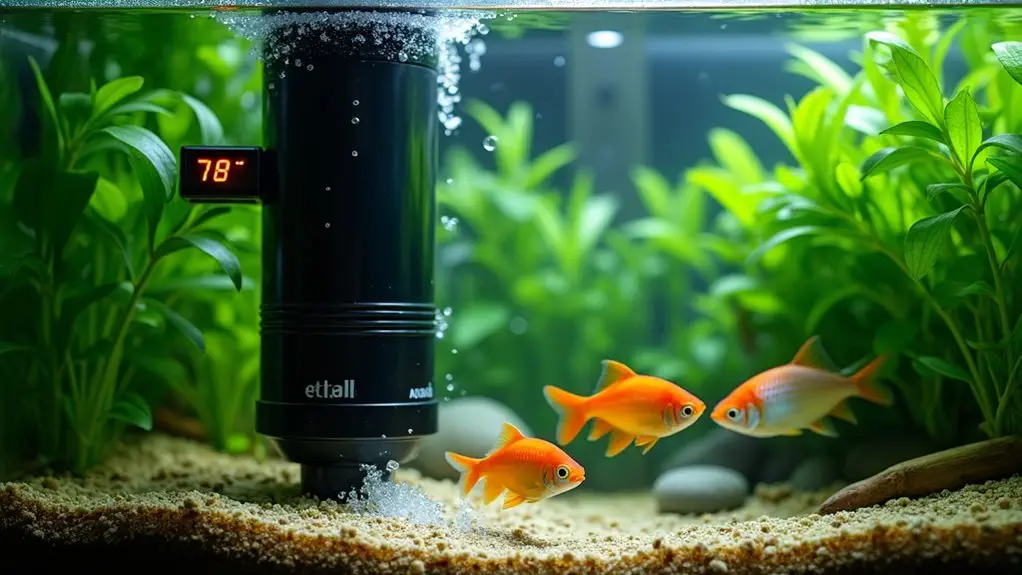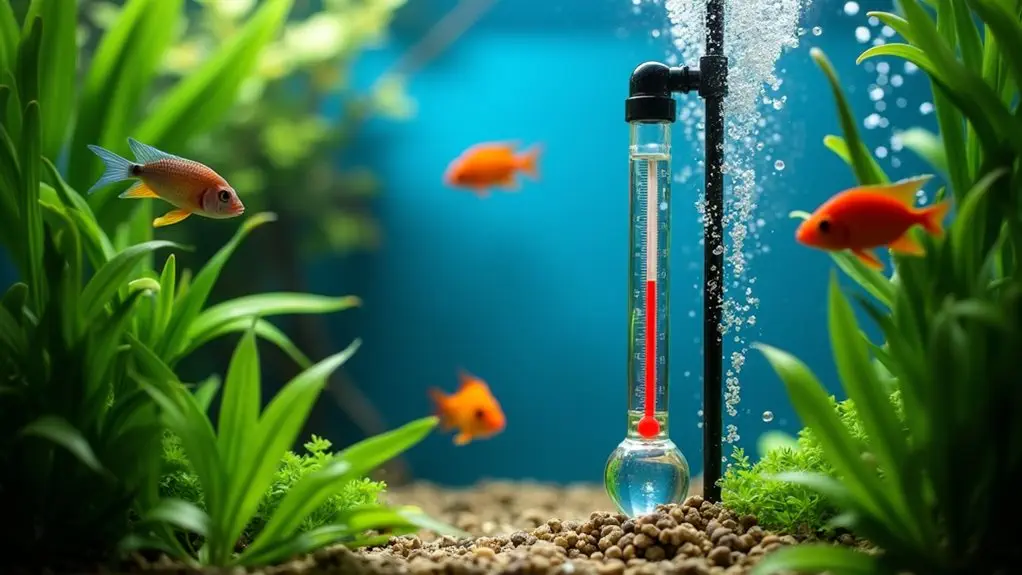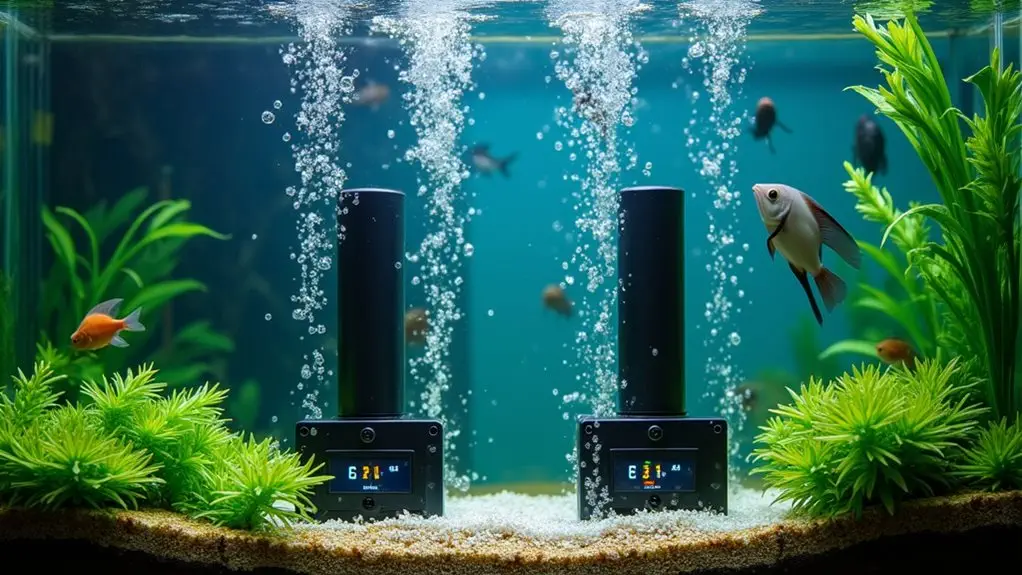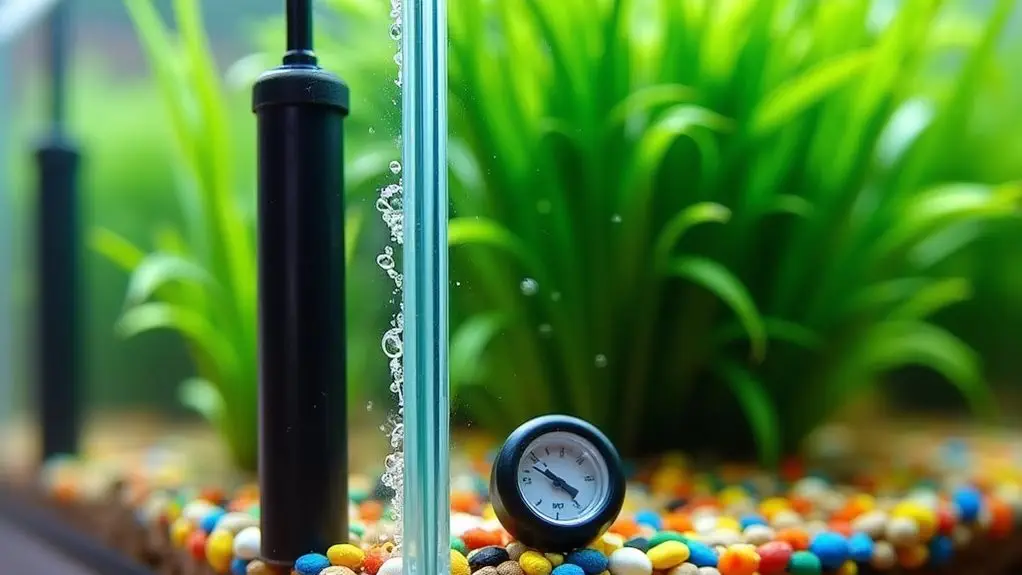Place your heater near the filter output for even heat distribution—about 5 watts per gallon works well. Position it horizontally in larger tanks or at a 45-degree angle for better coverage. Your thermometer should be on the opposite side from the heater for accurate readings, with digital models offering better precision than stick-ons. For tanks over 30 gallons, consider using two heaters at opposite ends. The perfect setup guarantees your fish thrive in their ideal temperature zone.
Contents
- 1 Fish Tank Heater and Thermometer Placement Guide
- 2 Understanding Your Aquarium's Heating Needs
- 3 Optimal Heater Placement for Different Tank Sizes
- 4 Strategic Thermometer Positioning for Accurate Readings
- 5 Creating Effective Heat Distribution With Water Flow
- 6 Common Heater Placement Mistakes to Avoid
- 7 How to Hide Heating Equipment While Maintaining Efficiency
- 8 Multiple Heater Setups for Larger Aquariums
- 9 Frequently Asked Questions
- 9.1 How Long Do Aquarium Heaters Typically Last Before Needing Replacement?
- 9.2 Can Fish Tank Heaters Cause Electrical Shocks if They Malfunction?
- 9.3 Is It Safe to Use Second-Hand or Used Aquarium Heaters?
- 9.4 How Quickly Should Heaters Warm up a Cold Water Tank?
- 9.5 Do Battery-Powered Thermometers Work Better Than Adhesive Strip Thermometers?
- 10 Final Thoughts
Fish Tank Heater and Thermometer Placement Guide

Two critical components of a successful aquarium setup are proper heater and thermometer placement.
When setting up your tank, you'll need to take into account various heater types, from submersible to hang-on models, each with specific installation requirements. Position your heater near water flow—like filter outputs—to guarantee even heat distribution throughout the tank.
Proper heater placement near water circulation ensures consistent temperatures—vital for your aquarium's ecosystem.
Don't forget thermometer accuracy is essential for your fishy friends' health!
Place your thermometer on the opposite side from your heater to get the most reliable reading of your tank's overall temperature. Digital thermometers typically offer better accuracy than stick-on varieties, which can be affected by room temperature.
Understanding Your Aquarium's Heating Needs
Your fish will thrive only when you've matched your heater to their specific temperature needs, which typically range from 72°F to 82°F depending on species.
The size of your aquarium directly impacts your heating requirements, with larger tanks needing more powerful heaters to maintain consistent temperatures.
You'll need to research your fish species carefully, as tropical community tanks require different heating setups than coldwater species or specialized biotopes. Maintaining dissolved oxygen levels is essential for ensuring a healthy environment for your aquatic life.
Temperature Range Requirements
When caring for aquatic life, maintaining the correct water temperature isn't just a suggestion—it's essential for survival. Different fish species have evolved in specific environments, and your tank needs to replicate these conditions.
Tropical freshwater fish typically thrive between 74-80°F (23-27°C), while coldwater species like goldfish prefer cooler waters around 65-72°F (18-22°C).
You'll need to research your specific fish's ideal temperature requirements before setting up your tank. Remember that temperature fluctuations can stress your aquatic friends, potentially weakening their immune systems or even proving fatal.
A variance of more than 2-3 degrees in either direction from their ideal temperature can cause problems. The goal is stability—your fish will thank you with vibrant colors, active behavior, and longer lives! Additionally, maintaining good filtration and regular water changes is crucial to stabilize water conditions and support the health of your fish.
Tank Size Matters
As you decide on heating equipment for your aquarium, the volume of water you're working with dramatically affects how heat distributes throughout the tank.
Larger tanks require more powerful heaters or multiple units working together to maintain consistent temperatures throughout the water column.
A good rule of thumb is to use 5 watts of heater power for each gallon of water in normal room conditions.
So your 20-gallon tank needs about 100 watts, while a 55-gallon setup requires around 275 watts.
Don't forget that tank dimensions play an essential role too!
Long, shallow tanks may need two smaller heaters placed at opposite ends rather than one powerful unit that could create hot spots.
You'll thank yourself later when your fish are swimming comfortably in evenly heated water instead of avoiding overheated zones. Additionally, maintaining stable pH levels within your heater setup can further enhance the overall health and comfort of your aquarium's inhabitants.
Species-Specific Needs
Different fish species have dramatically different temperature requirements that must be respected for their health and wellbeing. Tropical varieties might thrive at 78°F, while coldwater species could suffer at such warmth.
Before setting up your heater, research every fish in your tank to ascertain species compatibility.
Remember, temperature affects more than just survival—it influences behavioral factors too. Your normally active tetras might become sluggish in cooler water, while your goldfish could experience dangerous stress in tropical conditions.
You'll notice these changes if you're attentive to your aquatic friends.
When housing multiple species, you'll need to find their temperature "sweet spot" where all can thrive. This is especially crucial in community tanks, where maintaining a peaceful community is vital for fish well-being.
If you can't accommodate everyone's needs in one tank, it might be time to evaluate separate habitats for incompatible species.
Your fish will thank you!
Optimal Heater Placement for Different Tank Sizes
Your tank's size directly affects where you'll place your heater for maximum efficiency.
In smaller tanks (under 20 gallons), you'll want to position a single heater near your filter's water flow to guarantee even heat distribution throughout the tank.
For medium to large tanks (30+ gallons), you'll benefit from using multiple heaters placed in different zones, which creates a more consistent temperature environment and provides backup if one heater fails.
Tank Size Zones
The size of your aquarium greatly impacts where you should place your heater for ideal performance.
When considering tank dimensions, remember that larger tanks typically need heaters positioned horizontally near the bottom, where they can create effective heat zones throughout the aquarium.
For tanks under 20 gallons, place your heater at a 45-degree angle in a corner with good water flow.
Medium tanks (20-55 gallons) benefit from heaters positioned horizontally about 2 inches from the bottom.
If you've got a large tank over 55 gallons, you'll want to use multiple heaters placed at opposite ends to guarantee even temperature distribution.
Don't forget that tall, narrow tanks heat differently than short, wide ones – the shape matters just as much as volume!
Heat Distribution Efficiency**
Your aquarium naturally develops thermal layers, with warmer water rising to the top while cooler water settles at the bottom. To combat this stratification, position your heat sources in areas with good water movement.
For peak efficiency, place heaters near your filter output or water pump, allowing the current to disperse warmth evenly throughout the tank. You'll want to angle heaters slightly, about 45 degrees, to maximize their heating surface area.
In larger tanks, consider using multiple smaller heaters instead of one large unit—it's like having several small furnaces rather than one central heating system. This approach prevents cold spots and guarantees your finned friends enjoy consistent temperatures regardless of where they're swimming. Additionally, maintaining regular water testing ensures optimal conditions for your fish, further supporting the effectiveness of your heater placement.
Strategic Thermometer Positioning for Accurate Readings

When monitoring your aquarium's temperature effectively, proper thermometer placement can make all the difference between thriving fish and potential disaster.
You'll want to position your thermometer where it provides the most accurate reading of your tank's true water temperature. For best results, place your thermometer on the opposite side of the tank from your heater, at mid-water level. This guarantees you're measuring the overall tank temperature, not just the water near the heating element.
Check your thermometer calibration regularly, as even digital models can drift over time. Sensor accuracy depends greatly on placement—avoid direct sunlight, filter outputs, or decorations that might create micro-climates within your tank.
Creating Effective Heat Distribution With Water Flow
Achieving ideal heat distribution throughout your aquarium depends largely on proper water circulation, which carries warm water away from the heater and throughout the entire tank.
You'll want to position your heater near areas of good water movement, typically near your filter output or air stones, to maximize heat circulation.
Don't underestimate the power of strategic water flow! If you notice temperature "dead zones" in your tank (those cooler spots where fish might avoid), try adjusting your filter output or adding a small circulation pump.
Many experienced aquarists place their heaters horizontally near the bottom of the tank, allowing warm water to naturally rise and create gentle convection currents.
Common Heater Placement Mistakes to Avoid

Despite good intentions, many aquarium enthusiasts make critical mistakes when positioning their heaters, potentially endangering their aquatic pets.
You'll want to avoid placing your heater directly on the substrate, which can cause overheating or even heater malfunction. Different heater types have specific placement requirements—don't assume one-size-fits-all!
Another common blunder is positioning heaters near decorations or plants that might contact the heating element. Trust me, melted plastic ruins more than just your tank's aesthetics!
Also, don't tuck your heater in a corner with poor water circulation, as this creates dangerous hot spots.
Remember that positioning two heaters at opposite ends of your tank (for larger aquariums) provides more even heating than a single unit. Your fish will thank you for taking these extra precautions! Additionally, maintaining optimal water quality parameters is essential to enhance your fish's overall health and reduce stress.
How to Hide Heating Equipment While Maintaining Efficiency
Many aquarium enthusiasts face the challenge of balancing functionality with aesthetics when it comes to heating equipment.
You don't have to sacrifice the beauty of your underwater landscape for proper heating. With some creative solutions, you can effectively camouflage your heaters while ensuring they operate efficiently.
Here are four ways to conceal your heating equipment:
- Use aquatic plants (live or artificial) to create natural screens around heaters.
- Incorporate decorative covers specifically designed for aquarium equipment.
- Position equipment behind carefully arranged rock formations or driftwood.
- Install equipment camouflage materials that match your tank's background.
Multiple Heater Setups for Larger Aquariums

Larger aquariums over 50 gallons benefit considerably from multiple heater installations rather than relying on a single large unit.
You'll find that distributing heat evenly becomes much easier with strategic multiple heater configurations throughout your tank. For ideal results, place heaters at opposite ends of the aquarium to create consistent water temperature throughout.
When planning your setup, heater wattage calculations are essential – aim for about 5 watts per gallon, split between units.
For instance, a 100-gallon tank might use two 250-watt heaters rather than one 500-watt model. This redundancy isn't just about efficiency; it's also insurance against complete heating failure if one unit malfunctions.
Plus, smaller heaters cycling on and off create less dramatic temperature fluctuations, which your finned friends will definitely appreciate!
Frequently Asked Questions
How Long Do Aquarium Heaters Typically Last Before Needing Replacement?
Your aquarium heater's lifespan typically ranges from 3-5 years. You'll know it's time for replacement when you notice inconsistent temperatures, visible cracks, or the heater stops working altogether. Watch for these replacement signs.
Can Fish Tank Heaters Cause Electrical Shocks if They Malfunction?
Yes, malfunctioning heaters can shock you. Always unplug before handling and check for cracks regularly. Follow safety precautions like using a GFCI outlet and proper heater maintenance to protect yourself and your fish.
Is It Safe to Use Second-Hand or Used Aquarium Heaters?
Walking a tightrope with used heaters, you're gambling with your aquatic friends' lives. Don't skip thorough heater inspection for safety concerns—check for cracks, corrosion, or damaged cords before trusting second-hand equipment.
How Quickly Should Heaters Warm up a Cold Water Tank?
Your heater should warm a cold tank gradually, raising temperature about 1-2°F per hour. Quick heating affects efficiency and causes harmful temperature fluctuations. Don't rush the process; steady warming protects your aquatic pets.
Do Battery-Powered Thermometers Work Better Than Adhesive Strip Thermometers?
Like David versus Goliath, battery thermometers win hands down. They'll give you far better accuracy than adhesive strips, which often lag behind real temperatures. You'll get precise readings for monitoring your aquatic environment.
Final Thoughts
Just as a conductor positions each musician for perfect harmony, you'll create a balanced underwater symphony with proper heater and thermometer placement. Your finned friends will thrive when you've established ideal water circulation, hidden equipment strategically, and monitored temperatures accurately. Remember, your aquarium isn't just a glass box—it's a living ecosystem where every component plays its part. With these placement strategies, you're not just maintaining equipment—you're orchestrating an aquatic masterpiece!












